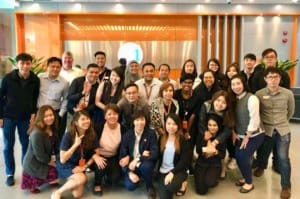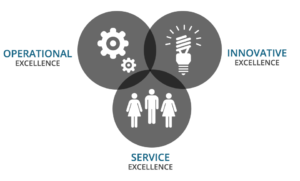In this article we share specific email writing tips for better Customer Experience and Service Recovery using a real case study at the Ritz Carlton, Santa Barbara.
The Ritz Carlton Hotels.
From their webpage:
100 years of history. Countless rewards. With an unshakeable credo and corporate philosophy of un-wavering commitment to service, both in our hotels and in our communities, The Ritz-Carlton has been recognized with numerous awards for being the gold standard of hospitality.
Santa Barbara, California.
The city lies between the steeply rising Santa Ynez Mountains and the Pacific Ocean. Santa Barbara’s climate is often described as Mediterranean, and the city is referred to as the “American Riviera”.
So, the expectations for service at the Ritz Carlton Bacara in Santa Barbara, California are understandably high.
The situation
On a recent holiday in the U.S. I spent time with my sister Diana who lives and has her business in Santa Barbara.

The Ritz Carlton Bacara, Santa Barbara
One evening she turned to us and said – let’s have a leisurely dinner at The Ritz Carlton Bacara tonight – to which we all emphatically nodded yes.
The following day, my sister sent a detailed email to the Ritz Carlton to share on our experience.
The purpose of this article is not to complain about service.
I’m not a fan of articles where Customer Service experts write to vent frustration or unhappiness under the guise of promoting Customer experience.
My intention in this article is to share email writing tips for better Customer experience and Service recovery efforts.
The email exchange with the Ritz Carlton provided a perfect and personal case study.
Here is the email my sister (the Customer) sent
Good Morning,
I am writing because I felt compelled after a bumpy visit to the resort yesterday in Santa Barbara and I thought it would be helpful for your managerial staff to be made aware of so many missed opportunities for our visit to have been special.
I have family in town from Singapore and Germany and felt a visit to the Bacara would cap off their trip spectacularly.
I made reservations for the Bistro at 5:30 to enjoy a leisurely time outside during a typically slow time for restaurants.
An hour after the reservation was made, Stephanie called from the Bistro and left a message to inquire whether we would want inside or outside, which I appreciated.
I called back a few minutes after her message and couldn’t reach anyone in the Bistro for a few tries (the PBX call bounced back to the operator).
When I reached her, I verified that we would be outside and see her in an hour and a half.

The Ritz Carlton Bacara, Santa Barbara
We parked in valet and entered the lobby where an absolutely spectacular floral arrangement greeted us. This was going to be great.
We reached the Bistro and the hostess stand was empty.
We waited a few minutes and Stephanie came up and greeted us and led us to our reserved table for four which was only set for three.
We sat and several minutes later the fourth setting arrived.
Approximately 10 minutes later bread arrived but no bread plates, so we waited another 10 minutes to give our order and at that point asked for bread plates.
Our Server was sweet but only came to the table a couple of times in the two hours we were there.
When we ordered our food, she didn’t ask about drinks, and on our side, we forgot to order them.

Risotto
The food came 45 minutes later, and the chicken/risotto dish was amazing (my visitors had this and they loved it).
I was beginning to get frustrated because of the wait times between visits to our table so we asked for the bill and a person we hadn’t seen yet brought it.
We decided that rather than leave straight away, we would have a drink/coffee in the bar and get a change of scenery.
At the bar the bartender told us that there is no coffee available at their bar but that they would get one from the restaurant.

The Ritz Carlton Bacara, Santa Barbara
We settled in front of the fireplace in the lobby and 30 minutes or more passed without any word or visit from the staff, so we left.
I was so disappointed because I felt like there were so many missed opportunities to be treated like welcome guests.
I truly hope this beautiful setting can be matched by top notch service soon.
Thank you for the opportunity to share our experience,
Best,
Diana
Here is the reply from ae Food & Beverage Director
From: “Lawrence Teatree” (names are changed)
Date: April 16, 2018 at 1:50:17 PM CDT
To:” <[email protected]>
Subject: Your stay at The Ritz-Carlton Bacara, Santa Barbara
Dear Mrs. XX,
Thank you for choosing to stay at the Ritz-Carlton Bacara, Santa Barbara and providing your honest feedback.
Providing the highest level of hospitality is our number one priority and we sincerely apologize for falling short of meeting your expectations.
We have shared your feedback with the Bistro and Bar team to ensure the necessary guidelines are in place to improve the restaurant experience. I have also passed your comments to our Chef regarding the risotto! Thanks!
I do appreciate you giving us the opportunity to restore your confidence in Food and Beverage by speaking to me directly. Please let me know the best contact number and time to reach you, or you can call me at any time at 805 XXX XXXX.
Once again, thank you for your valued feedback and we hope to serve you again whenever your travels bring you back to Santa Barbara.
Lawrence Teatree
Food and Beverage
The Ritz Carlton, Bacara Santa Barbara
Here are email writing tips for better Customer Experience – documented within the body of the reply
The Subject Line
From: Lawrence Teatree
Date: April 16, 2018 at 1:50:17 PM CDT
To:” <[email protected]>
Subject: Your stay at The Ritz-Carlton Bacara, Santa Barbara
With regard to the Subject Line, we were not hotel guests at the Bacara. We were clearly dinner guests.
The Subject Line made it clear that Alex had not read our email or that he was simply following standard (and robotic) protocols.
The Subject Line matters. It should be well crafted.
The Opening
Dear Mrs. XX,
Thank you for choosing to stay at the Ritz-Carlton Bacara, Santa Barbara and providing your honest feedback.
We did not stay at the Bacara, we were dinner guests. So, the Opening line is irrelevant at best, tone deaf at worst.
The Apology
Providing the highest level of hospitality is our number one priority and we sincerely apologize for falling short of meeting your expectations.
Lawrence is a Director of Food & Beverage.
Based on his title, the restaurant where we had dinner and the bar where we later tried to get coffee would both fall under his purview.
The email would have sounded a lot more personal if he referred to himself – “I” and not “we”.
For example:
I apologize that I and our Team fell short of meeting your expectations and that of your dinner Guests…
And by talking about himself and/or his Team, he would have demonstrated that he took ownership of the experience.
This Empathy statement would have sounded more human and sincere than “we sincerely apologize”.
If you need to use the word ‘sincere’ in a Customer communication, that’s already a red flag.
If you have to sincerely apologize, does that mean you have insincere apologies too?
The Corporate Speak
Now let’s get to the Corporate speak.
How does the following phrase help matters?
Providing the highest level of hospitality is our number one priority…
Is that so? Providing the highest level of hospitality is our number one priority?
The entire reason the Customer took the time and effort to write a long and detailed email is because that didn’t happen for her.
He might as well have written –

The Ritz Carlton Bacara, Santa Barbara
Providing the highest level of hospitality is our number one priority, except obviously what happened in your case…
When you make a mistake – you apologize first.
You don’t couch the apology in ‘corporate-speak’.
This statement, coming at the opening of the Empathy Statement, reduced the impact and sincerity of the apology.
It sounded robotic and scripted.
The Content
We have shared your feedback with the Bistro and Bar team to ensure the necessary guidelines are in place to improve the restaurant experience.
The Customer was very detailed.
She shared no less than 10 observations about the experience across both the restaurant and bar.

The Ritz Carlton Bacara, Santa Barbara
She took effort and time to help the Ritz Carlton improve and even references at the end of her email that “I truly hope this beautiful setting can be matched by top notch service soon.”
Lawrence’s reply did not address a single specific point out of the 10 raised – nor did he share any details of “ensuring the necessary guidelines are in place.”
Lawrence could have done so much to restore the confidence of the Customer.
While it may not be necessary to address each of the 10 points raised by the Customer, Lawrence could have better matched her effort.
He could have specifically shared what he was going to do with that information that had been given.
As an example – and with better service recovery in mind – he could have said –
With regard to the number of settings at the table when you were seated (3 vs. 4), we have asked the Team that takes our reservations to indicate clearly to our Servers, the number of diners expected and the preferred seating location.

The Ritz Carlton Bacara, Santa Barbara
I’m really glad you brought this to my attention.”
When you learn how to write an efficient & effective email, you learn that you need to address both the Tone of the Customer and the Content of the Customer.
This Customer deserved a better ‘Content Match’ than she received. She put a lot of effort and detail into her email.
That was not reciprocated in the reply.
I have also passed your comments to our Chef regarding the risotto! Thanks!
This was a nice statement and showed that Lawrence read the email.
The Recovery
I do appreciate you giving us the opportunity to restore your confidence in Food and Beverage by speaking to me directly. Please let me know the best contact number and time to reach you, or you can call me at any time at 805 XXX XXXX.
This invitation to reach out to him is excellent and shows a personal touch.
The recovery would have been so much more effective if the overall email had been better.
The Closing
Once again, thank you for your valued feedback and we hope to serve you again whenever your travels bring you back to Santa Barbara.
The Customer is a long-term resident of Santa Barbara – making assumptions that all your Guests are tourists or visitors is not very welcome for locals.
Lawrence Teatree
Food and Beverage
The Ritz Carlton, Bacara Santa Barbara
In closing
If you attend to Customers by email, it’s important to –
Know what your brand ‘voice’ is – and confirm that it sounds human. The days of Corporate speak and roboticism in email writing are over.
In this new world where chatbots and AI Assistants sound friendlier than a real human being does, humans should sound more human!
Understand that email is a complex form of one to one communication. Training and coaching really matter.
Ensure all your Customer channels are operating to the same, high standard.
I hope this article has been helpful!
 Daniel
Daniel
Daniel Ord / [email protected]





 So if you’re DHL, a major hotel chain or even McDonalds delivery – and your Customers still call you to place orders – you have to care.
So if you’re DHL, a major hotel chain or even McDonalds delivery – and your Customers still call you to place orders – you have to care. If the Service Level goes down during any interval – let’s say from 10:00 – 10:30 in the example shown here – the Customer wait time during that interval increases.
If the Service Level goes down during any interval – let’s say from 10:00 – 10:30 in the example shown here – the Customer wait time during that interval increases.
 95/5, 90/10, 100/15 – this level of Service Level objectives is typically associated with revenue generating Centres – or those that deal with life & death or mission critical issues.
95/5, 90/10, 100/15 – this level of Service Level objectives is typically associated with revenue generating Centres – or those that deal with life & death or mission critical issues.






 Over the course of a few small pages – in her painstakingly beautiful handwriting – she had written down about a dozen quotes.
Over the course of a few small pages – in her painstakingly beautiful handwriting – she had written down about a dozen quotes. When it comes to human frailty, foibles & emotions, there’s nothing new under the sun.
When it comes to human frailty, foibles & emotions, there’s nothing new under the sun.
 To solve that question requires courage.
To solve that question requires courage. The best Service Quality Managers are also inspiring people.
The best Service Quality Managers are also inspiring people. Mystery Shopper program, or Wave 23 of their Customer Satisfaction survey program.
Mystery Shopper program, or Wave 23 of their Customer Satisfaction survey program.



 The challenge for Team Leaders is that they either don’t know about the many different kinds of conversations at their disposal or they haven’t grown confident in the use of the conversations.
The challenge for Team Leaders is that they either don’t know about the many different kinds of conversations at their disposal or they haven’t grown confident in the use of the conversations.
 Senior management wants the essence of the organization to cascade throughout every department and level.
Senior management wants the essence of the organization to cascade throughout every department and level. When we teach the Vision, we help people understand that this is a point in time in the future (as in our organization aims to become…).
When we teach the Vision, we help people understand that this is a point in time in the future (as in our organization aims to become…).







 It’s never fun for a Training Provider to have to guess at what it is that you want – risky business indeed.
It’s never fun for a Training Provider to have to guess at what it is that you want – risky business indeed.









 “Hmmmm (they say to themselves) – how could I drag the calls today?”
“Hmmmm (they say to themselves) – how could I drag the calls today?”
 As I like to say when I transition into ‘guru’ mode – when your Agent achieves Quality – and it just feels right – then AHT will be what it will be.
As I like to say when I transition into ‘guru’ mode – when your Agent achieves Quality – and it just feels right – then AHT will be what it will be. Did you ever order chocolate lava cake for dessert in a restaurant? It’s delicious.
Did you ever order chocolate lava cake for dessert in a restaurant? It’s delicious.
 As the world increasingly becomes digital, Customers reach out to voice channels when their issue is complex or they are confused or unhappy with something.
As the world increasingly becomes digital, Customers reach out to voice channels when their issue is complex or they are confused or unhappy with something.